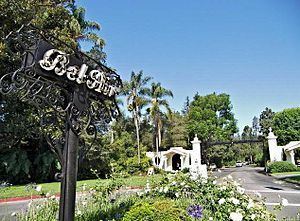City Los Angeles | ||
 | ||
East Gate Bel Air (or Old Bel Air) is a small and affluent area within the Bel Air section of Los Angeles, California. It is made up of large, old estates developed mostly before World War II.
Contents
Location
As shown in the “Bel Air First Residential Allotment” map from 1923, the original Bel Air tract of East Gate Old Bel Air founded and opened by Alphonzo E. Bell, Sr. was composed of 128 lots on Bel Air Road (which passes north from South Beverly Glen and Sunset Boulevards through the East Gate entrance—and hence the logical East Gate name) and the five roads which branch from it: Saint Pierre, Saint Cloud, Bellagio (to Stone Canyon), Copa De Oro, and Nîmes Roads. Though many of these 128 lots have since been combined into single properties, this original 1923 Bel Air allotment is what distinguishes East Gate Old Bel Air from the rest of present day Bel Air, which was gradually added by Bell starting in 1931 with Stone Canyon (known then as Bel Air Woodland), and by 1937 Bel Air extended westward all the way to Sepulveda Boulevard (its westernmost boundary today).
At its southernmost edge (where Copa de Oro Road meets Sunset Boulevard), East Gate Old Bel Air borders the campus of UCLA. At its easternmost edge, it borders Holmby Hills. This combined contiguous area of East Gate Bel Air and Holmby Hills straddles North Beverly Glen Boulevard (at a verdant bend of Saint Pierre Road and De Neve Square Park).
In general, the further one moves west from Saint Pierre Road to West Gate Lower Bel Air and north from Sunset Boulevard up the Santa Monica Mountains to Upper Bel Air, the smaller and the less flat the building lots and the more varied the styles and price ranges of the homes (with development fueled largely by postwar demand in the 1950s).
History
On the undeveloped hillsides of original Bel Air in 1922, Alphonzo Bell built water and sewage pipes, installed underground electric and telephone lines, and planted thousands of trees along winding streets traversing the hilly terrain. Bell refused to sell the original East Gate Old Bel Air allotments to anyone in the film business, though changed his mind on all of Bel Air with the arrival of the Great Depression. A design committee existed (and still exists to the present day) to preserve the “architectural harmony” of the community, with restrictions including low masses, horizontal lines, pitched roofs, and unobtrusive and harmonious colors, and deed restrictions required land purchasers to spend a minimum of $20,000 on home construction.
Demographics
East Gate Old Bel Air is unusual in having a rather high concentration of very large Republican Party contributors, as Los Angeles is otherwise heavily Democratic.
